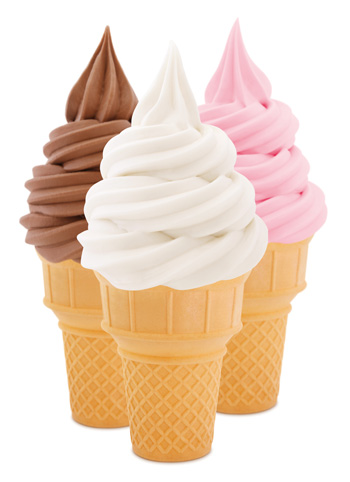Frozen dessert equipment dispenses ice cream, custard, yogurt and sorbet. Depending on the unit, these may produce and/or store a variety of products, including soft-serve desserts in single, twin twist or two separate flavors as well as shakes and ice cream cones. The main pieces of frozen dessert equipment include soft-serve machines, batch freezers and dipping cabinets.
 For ice cream and gelato, batch freezers produce, freeze and dispense these desserts, while operators use dipping cabinets to display and serve menu items.
For ice cream and gelato, batch freezers produce, freeze and dispense these desserts, while operators use dipping cabinets to display and serve menu items.
Batch freezers create high volumes of ice cream, frozen yogurt, gelato, sorbet, custard or other frozen dessert in a prescribed period of time. Most are rated by the barrel size ranging from 3 to 40 quarts. The barrel size is not necessarily indicative of the amount of product the machine will produce due to the amount of air that goes into a mix, also known as the overrun. The more butterfat, the faster the concoction takes on air.
The most critical batch freezer component is the beater or dasher, which adds air to the mixture while simultaneously scraping product from the barrel’s sides. The beater creates the proper consistency by pushing product into the barrel center and whipping it at the same time.
Batch freezers also include stainless-steel or plastic doors with grills on the front, along with two chutes. Located at the top of the door, the product chute is where users pour in the liquid mixture for the dessert, which is then outputted through the extraction chute. Newer batch freezers heat and freeze product to customize dessert offerings.
For ice cream, operators can choose from upright storage freezers available in a variety of sizes and widths. Available with either a solid or glass front, one-, two- and three-door units are most commonly used. Dipping cabinets are typically horizontal in format and range from 3 feet to 8 feet wide. The ideal ice cream holding temperature is -10 degrees F to prevent separation of the product and butterfat. Because gelato has a creamier consistency, operators should hold it at about 20 degrees F.
Standard features for these storage freezers include shelves or baskets for holding novelty items and dividers or organizers. Options include door locks and graphics for front-of-house merchandising. Dipping cabinets may offer night covers, frost shields on the interior for better viewing, water wells for rinsing utensils and a choice of casters or legs.
Frozen dessert equipment also includes soft-serve machines, which work by freezing liquid ice cream mix under agitation, then dispensing directly from the freezer into a cone or cup. These units can hold product in this frozen state for long periods until users dispense portions. Capacities range from 3.5 gallons per hour, or approximately 100 3.5-ounce servings per hour, to twist units that can produce 15 gallons per hour, or about 425 3.5-ounce servings per hour per side, for a total of 30 gallons per hour, equal to 850 3.5-ounce servings per hour. At the top end, units are available that produce up to 50 gallons per hour. Footprints range from 157/8 inches by 24¼ inches to 26 inches by 36½ inches.
The majority of the foodservice segment utilizes gravity-fed soft-serve machines, where the unit stores and refrigerates the mix in the hopper on the top of the freezer. Because this machine type limits the amount of air in the product, after four hours, the product can get dense and the viscosity more difficult to control.
Pressurized machines use a mix transfer system that pumps the mix from a container located in a refrigerated compartment below the cylinders up to the cylinders.
Overrun, or the amount of air introduced into the product, differs with these two machines. While gravity systems typically run at 42 percent overrun, pressurized units run at 60 percent.
Because soft-serve machines generate a great deal of heat due to their use of strong compressors, these units offer either air- or water-cooled condensing systems similar to those in refrigeration systems.
Some units feature Wi-Fi, internet logging capabilities to track ice cream production and other computerized features that give operators more control over the end product. The latest soft-serve freezers’ functions are controlled by a microprocessor. These control interfaces have icons on touch screens for simple operation. A newer option is a heat treat feature, which allows the machine to operate for two weeks without being disassembled for cleaning.
Manufacturers have reduced the amperage on soft-serve machine motors where possible so electric consumption is reduced. Switches on these units allow the operator to reduce the frequency so that the refrigeration system cools at night or during low-demand periods, which also reduces electric consumption.










